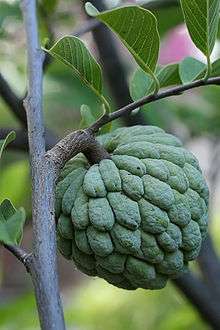Sugar-apple
The sugar-apple, or sweetsop, is the fruit of Annona squamosa, the most widely grown species of Annona and a native of the tropical Americas and West Indies. The Spanish traders of Manila galleons brought it to Asia.[1] The name is also used in Portuguese as ata.


The fruit is spherical-conical, 5–10 cm (2.0–3.9 in) in diameter and 6–10 cm (2.4–3.9 in) long, and weighing 100–240 g (3.5–8.5 oz), with a thick rind composed of knobby segments. The color is typically pale green through blue-green, with a deep pink blush in certain varieties, and typically has a bloom. It is unique among Annona fruits in being segmented, and the segments tend to separate when ripe, exposing the interior.
The flesh is fragrant and sweet, creamy white through light yellow, and resembles and tastes like custard. It is found adhering to 13-to-16-millimetre-long (0.51 to 0.63 in) seeds forming individual segments arranged in a single layer around a conical core. It is soft, slightly grainy, and slippery. The hard, shiny seeds may number 20–40 or more per fruit and have a brown to black coat, although varieties exist that are almost seedless.[1][2]
There are also new varieties being developed in Taiwan. The atemoya or "pineapple sugar-apple," a hybrid between the sugar-apple and the cherimoya, is popular in Taiwan, although it was first developed in the US in 1908. The fruit is similar in sweetness to the sugar-apple but has a very different taste. As its name suggests, it tastes like pineapple.
Nutrition and uses
| Nutritional value per 100 g (3.5 oz) | |
|---|---|
| Energy | 393 kJ (94 kcal) |
23.64 g | |
| Dietary fiber | 4.4 g |
0.29 g | |
2.06 g | |
| Vitamins | Quantity %DV† |
| Thiamine (B1) | 10% 0.11 mg |
| Riboflavin (B2) | 9% 0.113 mg |
| Niacin (B3) | 6% 0.883 mg |
| Pantothenic acid (B5) | 5% 0.226 mg |
| Vitamin B6 | 15% 0.2 mg |
| Folate (B9) | 4% 14 μg |
| Vitamin C | 44% 36.3 mg |
| Minerals | Quantity %DV† |
| Calcium | 2% 24 mg |
| Iron | 5% 0.6 mg |
| Magnesium | 6% 21 mg |
| Manganese | 20% 0.42 mg |
| Phosphorus | 5% 32 mg |
| Potassium | 5% 247 mg |
| Sodium | 1% 9 mg |
| Zinc | 1% 0.1 mg |
| |
| †Percentages are roughly approximated using US recommendations for adults. Source: USDA Nutrient Database | |
Sugar-apple is high in energy, an excellent source of vitamin C and manganese, a good source of thiamine and vitamin B6, and provides vitamin B2, B3 B5, B9, iron, magnesium, phosphorus and potassium in fair quantities.[3]
For uses of other fruit from the Custard-apple family see:
- Atemoya (a hybrid between A. squamosa and A. cherimoya)
- Cherimoya
- Custard-apple
Gallery
See also
References
- Morton, Julia (1987). "Annona squamosa". Fruits of warm climates. p. 69. Retrieved 6 March 2013.
- "Annona squamosa". AgroForestryTree Database. Archived from the original on 14 March 2007. Retrieved 16 September 2013.
- "Benefits of Custard apple". 22 December 2014.
External links
| Wikimedia Commons has media related to Sugar-apple. |
| Wikisource has the text of a 1911 Encyclopædia Britannica article about Sugar-apple. |
- Flora of North America: Annona squamosa
- "Annona squamosa". Germplasm Resources Information Network (GRIN). Agricultural Research Service (ARS), United States Department of Agriculture (USDA).
- Fruits from Americas: Annona squamosa
- Pacific Island Ecosystems at Risk: Annona squamosa
- Growing Sugar Apple Annona squamosa


_interior.jpg)


